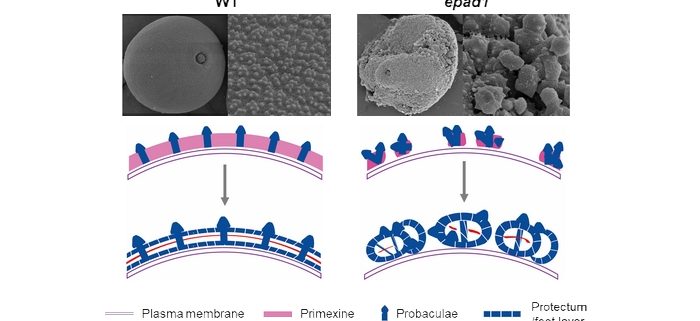Designer for Pollen Wall Surface Pattern Formation
By HuanJun Li, Yu-Jin Kim and Wanqi Liang
Background: Pollen, the male gametophyte in flowering plants, is enclosed within a thick and extremely resistant wall that protects it from environmental stresses during dispersal and pollination. The pollen wall consists of a featureless inner cellulose wall and an outer sporopollenin wall (named exine) that exhibits a highly diversified but also species-specific surface pattern. During pollen development, exine components (sporopollenin precursors) are synthesized and transported from the surrounding mother tissue (the tapetum), then assembled into delicate sculptures on the pollen surface under strict genetic control. The template for sporopollenin deposition and polymerization is the primexine that appears on the tetrad microspore surface. Although the process of pollen wall formation is similar between plants, we know little about how different plants develop their characteristic exine pattern. However, known genetic factors that control the exine wall formation also appear to be widely conserved in flowering plants. So far, no species-specific factors have been found that play a role in exine patterning. It is also unclear whether the reproductive cell factor is required to determine the exine pattern.
Question: We wanted to know whether species-specific genetic factors are required and how the microspore itself is involved in determining pollen exine pattern.
Findings: We identified a new exine patterning factor from rice, named EXINE PATTERN DESIGNER 1 (EPAD1), which belongs to a grass-specific lipid transfer protein (LTP) family. Without EPAD1, rice pollen displays altered exine ornamentation, though the exine materials can be made and transferred from the surrounding mother tissue normally. The abnormalities in pollen wall formation is the consequence of disruption in the primexine integrity. EPAD1 is generated in the pollen mother cell during meiosis and located to the plasma membrane of microspores after meiosis. EPAD1 is able to bind a range of phospholipids. We propose that EPAD1 itself and/or phospholipids bound by EPAD1 may be involved in recruiting and arranging regulatory proteins in the primexine that drive correct exine wall materials deposition.
Next steps: We are working on EPAD1 homologous proteins in other grass plants to elucidate whether these proteins are also involved in grass-specific exine pattern formation.




